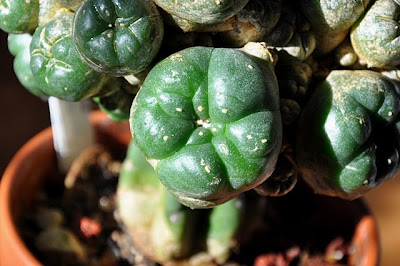
Lophophora williamsii f. cristata, top view
Last Sunday I went on a shopping spree and ordered some Lophophora alberto-vojtechii seeds from Köhres and a Lophophora williamsii f. cristata plant from Cactus Plaza.

Crested Lophophora williamsii, front view
The crested L. williamsii arrived yesterday without a scratch and looks exactly as advertised with a length of 4.2 cm and grafted on a Trichocereus pachanoi stock; the width of the crest is 2.5 cm.

Lophophora williamsii f. cristata, side view
I have never grown fasciated Lophophora before and look forward to follow the plant in the years to come. I'm particularly curious to see if the fasciation also affects the flowers or if they develop normally.

Fasciated Lophophora williamsii, the other front
I'm happy as can be with my new acquisition while “She Who Must Be Obeyed” gently shakes her head in silent disbelief ;-)

Crested Lophophora williamsii grafted on Trichocereus pachanoi stock
Sunday, November 08, 2009
Lophophora williamsii f. cristata (crested / fasciated peyote cactus)
Friday, November 06, 2009
Lophophora alberto-vojtechii seeds

Flowering Lophophora alberto-vojtechii, San Luis Potosi
Yesterday I received my first ever seeds of the newly described Lophophora alberto-vojtechii. These seeds are still rarely offered and consequently the price is quite high so I only bought one packet containing 10 seeds. I got the L. alberto-vojtechii (San Luis Potosi, Mexico) seeds from Gerhard Köhres who charges 16 euro (~ 24 USD) per packet.
Lophophora alberto-vojtechii, San Luis Potosi
I'm exited to see how these seeds develop and look forward to the coming growing season (I suppressed a momentary urge to plant the seeds immediately and they are now safely awaiting the coming spring in the refrigerator ;-)
If you also want some of Köhres's Lophophora alberto-vojtechii seeds you can buy them from Lophophora.info (go to the "list" submenu) or from the online shop at Köhres Kaktus. It's too early to say anything about the quality of the seeds but the delivery was impressive; the seeds arrived only 3 days after I ordered them.
The photos featured in this post are from Gerhard Köhres's Lophophora.info site (go to the "habitat gallery" submenu). You can find the original pictures here and here along with more Lophophora alberto-vojtechii photos from the San Luis Potosi habitat.
Tuesday, November 03, 2009
Lophophora williamsii v. caespitosa graft – 5th anniversary
I'm sad to say that I have neglected this plant in more than one respect. First I forgot to post on its 5th “grafting anniversary” (this post is almost 5 months due), secondly I didn't check up on it all summer even though it had recently been under attack by red spider mites.

Lophophora williamsii v. caespitosa grafted on Trichocereus stock
As is evident from the pictures I didn't manage to get the mites fully under control before leaving the plant unattended for most of the hot summer months, during which the mites prospered and had a feast on the poor cactus.

Severe spider mite damage
I'm controlling the mites using neem oil, soap, and regular showers – I have considered miticides but am convinced that Darwinistic selection forces will kick in, leaving me with a population of miticide resistant spider mites in the windowsill ;-) I read somewhere that sulfur mixed in with the topsoil repels mites so I might try that (the less aesthetically pleasing solution is to dust the plants with sulfur). Hydrogen peroxide is also said to kill off mites so I still have a couple of options to try out before opting for the harsher chemicals.

Relatively undamaged button
Large areas of the grafted Lophophora williamsii v. caespitosa are still relatively unaffected by the mites so I'm sure it will grow back given time. I'm a bit puzzled, though, why this particular plant is so popular with the mites compared to most other plants in my collection.

Top view of grafted Lophophora williamsii v. caespitosa
For comparison you can check the posts on the same plant one, two, three, and four years ago.
All Time Most Popular Posts
-
Lophophora williamsii (peyote) populations have diminished in large areas of South Texas where peyoteros harvest the cactus for ceremonial ...
-
On various occasions I've been asked what growing media I'm using for my cactus plants. I don't have a set soil mix recipe as su...
-
Below is a list of retailers/nurseries selling cactus seed and plants. I've only listed vendors I've done business with. If you ar...
-
Most cacti are easily grown from seed - and with a little patience and care they can be grown into beautiful plants. Lophophora williamsi...
-
In last month’s post on the troubled Texan peyoteros I referred to Anderson’s article on the peyote situation in Texas. Given the importanc...
-
Yet another slightly off topic and probably not entirely politically correct post, but I couldn’t help noticing the similarity of my monstr...
-
Flowering stand of San Pedro cacti (Trichocereus pachanoi) To me the main draw of the San Pedro cactus ( Trichocereus pachanoi (syn. Ech...
-
In the June 2008 issue of the Cactus & Co magazine Jaroslav Šnicer, Jaroslav Bohata, and Vojtěch Myšák described a new Lophophora spec...
-
There seems to be an increased focus on the alarming Texas peyote situation. A couple of weeks ago the Houston Press published a mournful, i...
-
I spent two weeks working in Delhi, India during January. I had one weekend off and had planned to spend it in Delhi at my own leisure, but ...


















